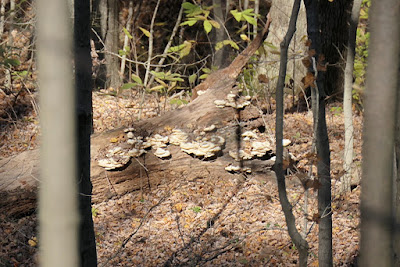In
October and November of 2020 Joan and I made four trips to Great Seal
State Park, to hike and thus explore this park for the first time,
getting outdoors during the pandemic. This post is part three of three
about Great Seal, covering the fourth hike, on November 20th. Part one of
the series is here, and part two is here.
The park is named "Great Seal" because the hills of the park are a feature of the State Seal of Ohio. They are part of the view from Adena Mansion, the home of Thomas Worthington, Ohio's sixth governor.
Here is an overall map of the trail systems, which curl around and up and down the terrain. Click on the image to enlarge. As you can see from the map, the park is much taller, north-to-south, than wide.
Many of the trails are multi-purpose, with foot, horse, and off-road bicycle traffic allowed. In addition, there is a spider-web of narrow bike trails that are unsuitable for horses and lack the signage of the multi-purpose routes.
Joan and I drove to the southernmost parking area, off Lick Run, where we'd parked twice before.
There is a bench here dedicated to Annie Rooney, the guiding light and spark plug for the creation of the bike trails here; she was killed by a drunk driver in 2013.The parking area is at location V on this map. We began by taking the Lick Run trail to intersection M, then up the Mt. Ives trail to W. (Click on the image to enlarge.)On this day we spotted a great many pear-shaped puffball mushrooms, Lycoperdon pyriforme or, since 2017, Apioperdon.
Joan enjoys assisting their spore dispersal, as you can see in this short video.
At W, another Annie Rooney bench.
As we continued on to intersection N Joan spotted some crane-fly orchid (Tipularia discolor) leaves, easily identified by their green upper surface and purple underside. A single leaf emerges in September and disappears in the spring, the opposite of what you'd expect.When we reached Y, at a park boundary, we encountered this sign.Unexploded ammunition? It likely rocketed here from Camp Sherman, now the National Guard Camp Sherman Training Center. Camp Sherman was hastily erected in 1917, just a mile or less away,when the United States entered the First World War. By the time it was decommissioned in 1921, over 120,000 men had passed through for training -- including the 324th Field Artillery. We were not tempted to enter the forbidden zone. Instead, Joan and I looped around to intersection P, and visited the Bunker Hill ridge top again.A panoramic view from the swing bench at the tip of the ridge.Since our last visit to this spot someone had installed some solar powered lights.I wonder what it looked like at night from the houses below.
Joan and I continued clockwise on the outer loop, the section of Bunker Hill we hadn't walked through before. Wavy trees stood like kelp in salt water.
Not all were still upright.We also passed an old stone structure, long disused.The trail lost altitude, and with the leaves fallen from the trees, we could see that were were close to some houses at the edge of the park.More fungi along the way.
Joan and I continued through point Q and towards R,
and we reached a surprise, a "Trail Pod" with a McLeod tool and a sign. (Click on the image to enlarge.)Volunteers can scan the QR codes to sign in, review the trail guidelines, use the McLeod to improve the trail, and sign back out. This was designed for individual effort, given that there was only one tool. Intriguing!
We dropped down to the trail next to the road on what might have been a bike trail, or just a well-trodden shortcut. (It was an unmarked, unexpected intersection). Then heading north we crossed the road at intersection J and continued through S and then K to reach the Bonus Hill trail.
At the right spot for the intersection, which has no designation, we saw just a small sign on a tree, as if for a bike trail, and the name was not "Bonus Hill." However, it being in the anticipated location, we took it. The trail curved and turned and crossed the Rocky Knob trail, which we took to L. To finish our return we headed right on the Mt. Ives trail, aiming to cross the road to hit M. But partway back -- well past the unmarked green trail departure to the right -- the trail forked and confused us. Which was the true path and which was an unmarked alternate, another pesky bike path? We went partway on the straight-ahead fork, then returned to take the left fork, then gave up on that when we saw a huge tree trunk across the trail, retraced our steps and regained the straight fork. Of course, that turned out to be wrong choice, a bike trail, which wiggled and wound until it hit the Lick Run trail, which we descended to cross the road directly across from the parking area. You can't get lost in Great Seal, but you can easily take the longer way when coping with unmarked intersections!
Great Seal State Park has been a great find, and it will be fun to visit it in different seasons. (One advantage of winter workdays is the scarcity of other visitors.)



























































